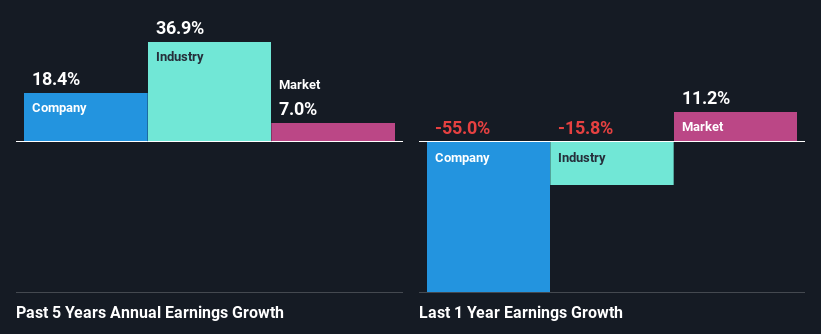Declining Stock and Decent Financials: Is The Market Wrong About Kumba Iron Ore Limited (JSE:KIO)?
Kumba Iron Ore (JSE:KIO) has had a rough three months with its share price down 8.8%. But if you pay close attention, you might find that its key financial indicators look quite decent, which could mean that the stock could potentially rise in the long-term given how markets usually reward more resilient long-term fundamentals. Specifically, we decided to study Kumba Iron Ore's ROE in this article.
Return on Equity or ROE is a test of how effectively a company is growing its value and managing investors’ money. Simply put, it is used to assess the profitability of a company in relation to its equity capital.
See our latest analysis for Kumba Iron Ore
How To Calculate Return On Equity?
The formula for return on equity is:
Return on Equity = Net Profit (from continuing operations) ÷ Shareholders' Equity
So, based on the above formula, the ROE for Kumba Iron Ore is:
37% = R20b ÷ R54b (Based on the trailing twelve months to December 2022).
The 'return' is the amount earned after tax over the last twelve months. So, this means that for every ZAR1 of its shareholder's investments, the company generates a profit of ZAR0.37.
What Is The Relationship Between ROE And Earnings Growth?
We have already established that ROE serves as an efficient profit-generating gauge for a company's future earnings. Based on how much of its profits the company chooses to reinvest or "retain", we are then able to evaluate a company's future ability to generate profits. Assuming all else is equal, companies that have both a higher return on equity and higher profit retention are usually the ones that have a higher growth rate when compared to companies that don't have the same features.
A Side By Side comparison of Kumba Iron Ore's Earnings Growth And 37% ROE
To begin with, Kumba Iron Ore has a pretty high ROE which is interesting. Secondly, even when compared to the industry average of 21% the company's ROE is quite impressive. This probably laid the groundwork for Kumba Iron Ore's moderate 18% net income growth seen over the past five years.
We then compared Kumba Iron Ore's net income growth with the industry and found that the company's growth figure is lower than the average industry growth rate of 37% in the same 5-year period, which is a bit concerning.
The basis for attaching value to a company is, to a great extent, tied to its earnings growth. What investors need to determine next is if the expected earnings growth, or the lack of it, is already built into the share price. This then helps them determine if the stock is placed for a bright or bleak future. If you're wondering about Kumba Iron Ore's's valuation, check out this gauge of its price-to-earnings ratio, as compared to its industry.
Is Kumba Iron Ore Using Its Retained Earnings Effectively?
Kumba Iron Ore has a significant three-year median payout ratio of 92%, meaning that it is left with only 7.8% to reinvest into its business. This implies that the company has been able to achieve decent earnings growth despite returning most of its profits to shareholders.
Moreover, Kumba Iron Ore is determined to keep sharing its profits with shareholders which we infer from its long history of paying a dividend for at least ten years. Upon studying the latest analysts' consensus data, we found that the company's future payout ratio is expected to drop to 67% over the next three years. However, Kumba Iron Ore's future ROE is expected to decline to 24% despite the expected decline in its payout ratio. We infer that there could be other factors that could be steering the foreseen decline in the company's ROE.
Summary
On the whole, we do feel that Kumba Iron Ore has some positive attributes. The company has grown its earnings moderately as a result of its impressive ROE. Yet, the business is retaining hardly any of its profits. This might have negative implications on the company's future growth. With that said, the latest industry analyst forecasts reveal that the company's earnings growth is expected to slow down. Are these analysts expectations based on the broad expectations for the industry, or on the company's fundamentals? Click here to be taken to our analyst's forecasts page for the company.
Have feedback on this article? Concerned about the content? Get in touch with us directly. Alternatively, email editorial-team (at) simplywallst.com.
This article by Simply Wall St is general in nature. We provide commentary based on historical data and analyst forecasts only using an unbiased methodology and our articles are not intended to be financial advice. It does not constitute a recommendation to buy or sell any stock, and does not take account of your objectives, or your financial situation. We aim to bring you long-term focused analysis driven by fundamental data. Note that our analysis may not factor in the latest price-sensitive company announcements or qualitative material. Simply Wall St has no position in any stocks mentioned.
Join A Paid User Research Session
You’ll receive a US$30 Amazon Gift card for 1 hour of your time while helping us build better investing tools for the individual investors like yourself. Sign up here

